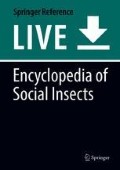References
Adams, E. S. (2016). Territoriality in ants (Hymenoptera: Formicidae): A review. Myrmecological News, 23, 101–118.
Ayasse, M., & Paxton, R. J. (2003). Brood protection in social insects. In Chemoecology of insect eggs and egg deposition, Blackwell Verlag GmbH, Berlin-Vienna (pp. 117–148).
Blum, M. S. (1969). Alarm pheromones. Annual Review of Entomology, 14, 57–80.
Breed, M. D. (2014). Kin and nestmate recognition: The influence of W. D. Hamilton on 50 years of research. Animal Behaviour, 92, 271–279.
Breed, M. D., Cook, C., & Krasnec, M. O. (2012). Cleptobiosis in social insects. Psyche: A Journal of Entomology, 2012, 1–7.
Buschinger, A. (2009). Social parasitism among ants: A review (Hymenoptera: Formicidae). Myrmecological News, 12, 219–235.
Deligne, J., Quennedey, A., & Blum, M. S. (1981). The enemies and defense mechanisms of termites. In H. R. Hermann (Ed.), Social insects (Vol. II). Academic Press Inc, New York.
Dettner, K., & Liepert, C. (1994). Chemical mimicry and camouflage. Annual Review of Entomology, 39, 129–154.
Dos Santos-Pinto, J. R. A., Perez-Riverol, A., Lasa, A. M., & Palma, M. S. (2018). Diversity of peptidic and proteinaceous toxins from social Hymenoptera venoms. Toxicon, 148, 172–196.
Duangphakdee, O., Koeniger, N., Deowanish, S., Hepburn, H. R., & Wongsiri, S. (2009). Ant repellent resins of honeybees and stingless bees. Insectes Sociaux, 56, 333–339.
Gordon, D. M. (1996). The organization of work in social insect colonies. Nature, 380, 121–124.
Hepburn, H. R. (2011). Absconding, migration and swarming. In H. R. Hepburn & S. E. Radloff (Eds.), Honeybees of Asia (pp. 133–158). Berlin/Heidelberg: Springer.
Hermann, H. R., & Blum, M. S. (1981). Defensive mechanisms in the social Hymenoptera. In H. R. Hermann (Ed.), Social insects (Vol. II, pp. 78–198). Academic Press Inc, New York.
Jeanne, R. L. (1975). The adaptiveness of social wasp nest architecture. The Quarterly Review of Biology, 50, 267–287.
Lenoir, A., D'Ettorre, P., Errard, C., & Hefetz, A. (2001). Chemical ecology and social parasitism in ants. Annual Review of Entomology, 46, 573–599.
Leonhardt, S. D. (2017). Chemical ecology of stingless bees. Journal of Chemical Ecology, 43, 385–402.
McGlynn, T. P. (2012). The ecology of nest movement in social insects. Annual Review of Entomology, 57, 291–308.
Nieh, J. C. (2010). A negative feedback signal that is triggered by peril curbs honey bee recruitment. Current Biology, 20, 310–315.
Noirot, C., & Darlington, J. P. E. C. (2000). Termite nests: Architecture, regulation and defence. In T. Abe, D. E. Bignell, & M. Higashi (Eds.), Termites: Evolution, sociality, symbioses, ecology. Dordrecht: Springer.
Nouvian, M., Reinhard, J., & Giurfa, M. (2016). The defensive response of the honeybee Apis mellifera. Journal of Experimental Biology, 219, 3505–3517.
Nouvian, M., Mandal, S., Jamme, C., Claudianos, C., d’Ettorre, P., Reinhard, J., Barron, A. B., & Giurfa, M. (2018). Cooperative defence operates by social modulation of biogenic amine levels in the honey bee brain. Proc. R. Soc B 285: 20172653
Prestwich, G. D. (1984). Defense mechanisms of termites. Annual Review of Entomology, 29, 201–232.
Rivera-Marchand, B., Giray, T., & Guzmán-Novoa, E. (2008). The cost of defense in social insects: Insights from the honey bee. Entomologia Experimentalis et Applicata, 129, 1–10.
Roubik, D. W. (2006). Stingless bee nesting biology. Apidologie, 37, 124–143.
Shorter, J. R., & Rueppell, O. (2012). A review on self-destructive defense behaviors in social insects. Insectes Sociaux, 59, 1–10.
Tian, L., & Zhou, X. (2014). The soldiers in societies: Defense, regulation, and evolution. International Journal of Biological Sciences, 10, 296–308.
Vander Meer, R. K. (1998). Pheromone communication in social insects: Ants, wasps, bees, and termites. Westview Press.
Author information
Authors and Affiliations
Corresponding author
Editor information
Editors and Affiliations
Rights and permissions
Copyright information
© 2020 Springer Nature Switzerland AG
About this entry
Cite this entry
Nouvian, M., Breed, M.D. (2020). Colony Defense, Survival and Reproduction. In: Starr, C. (eds) Encyclopedia of Social Insects. Springer, Cham. https://doi.org/10.1007/978-3-319-90306-4_25-2
Download citation
DOI: https://doi.org/10.1007/978-3-319-90306-4_25-2
Received:
Accepted:
Published:
Publisher Name: Springer, Cham
Print ISBN: 978-3-319-90306-4
Online ISBN: 978-3-319-90306-4
eBook Packages: Springer Reference Biomedicine and Life SciencesReference Module Biomedical and Life Sciences
Publish with us
Chapter history
-
Latest
Colony Defense, Survival and Reproduction- Published:
- 02 June 2020
DOI: https://doi.org/10.1007/978-3-319-90306-4_25-2
-
Original
Colony Defense- Published:
- 17 January 2020
DOI: https://doi.org/10.1007/978-3-319-90306-4_25-1

